Apart from the beauty of the Himalayas and richness in natural resources, Nepal is also known for its distinct culture and colorful, vibrant festivals. Despite being small in size, the Himalayan nation is home to people of various cultures and ethnicities with different traditions and festivities. Most of the festivals celebrated in Nepal have religious connotations, and some are based on important events from ancient mythology and epic literature.

As a result of different ethnic backgrounds, Nepalese people have diverse beliefs and cultures. Despite that fact, everyone unites for the celebration of the major festivals. Festivals such as Dashain and Tihar are of national significance; such as Bisket Jatra or Rato Machchhendranath Jatra, belong to the traditions of the old Valley towns and still others, such as Chat, are observed only by a particular ethnic community.
The vivid cultural diversity of Nepal can be observed in the form of different festivals celebrated in the country. To give a closer look at Nepal’s diversity, here are 10 major festivals in Nepal.
1. Dashain and Tihar
– Biggest Festivals of Nepal

The biggest and most popular festivals in Nepal are Dashain and Tihar. Dashain, a celebration of Goddess Durga’s victory over evil Mahishasura, as per Hindu mythology, whereas Tihar is a celebration of lights and color dedicated to Goddess Laxmi- the god of riches and prosperity as per Hindu mythology. Although these festivals are connected with a particular religion, their symbolic meaning is deeply rooted in Nepalese society. Despite their religious beliefs, people of every ethnicity celebrate Dashain and Tihar with the same joy and excitement. The two festivals fall in the autumn season and are observed as the longest festival holiday.
Nepalese people celebrate Dashain for 15 days by spending time with their family members eating delicious foods and receiving tika and blessings from the elderly. And after two weeks of Dashain comes Tihar- festival of lights and flowers. Tihar is celebrated for five days; it is also the festival on which Nepalese people worship dogs for their loyalty, offering them garlands and good food. Further, the last day of Tihar- Bhaitika, celebrates the bond of a brother and sister’s relationship.
2. Buddha Jayanti
– The Day Gautam Buddha was Born
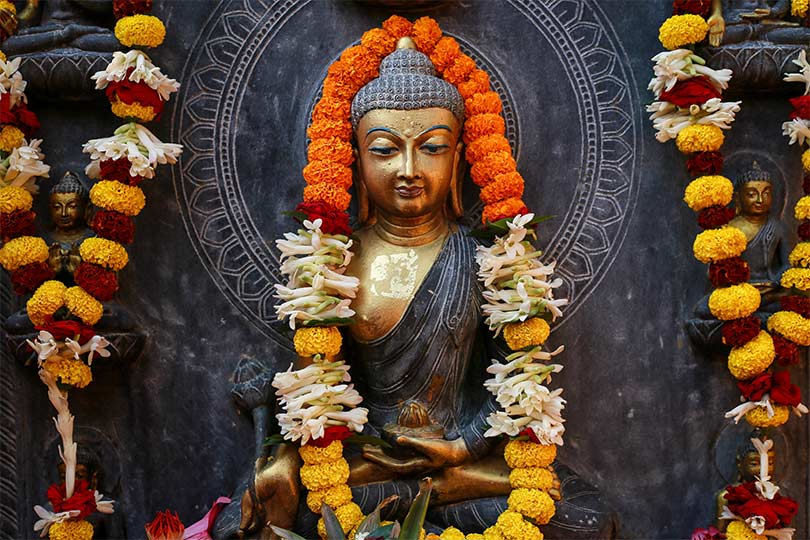
Buddha Jayanti is celebrated to mark the birthday of the Lord Buddha. Gautam Buddha was born in 623 BC as a prince of the Shakya dynasty in Lumbini, which now falls in the Kapilvastu district of Nepal. Since it is the birthplace of Budhha, Nepal celebrates Buddha Jayanti as one of its grand festivals. It falls on the full moon night of either May or June. The peace lover and Buddhist communities like to make their pilgrimage to Buddha’s birthplace, Lumbini of Nepal, on this auspicious day. Further, the Buddhist monasteries, chaityas, and gumbas are decorated and crowded with numerous visitors on Buddha Jayanti.
3. Gai Jatra
– The Cow festival

The word Gai Jatra translates as the cow carnival. But the festival is celebrated to commemorate the death of loved ones. People sing, dance and dress as cows to parade on the street. It is a festival celebrated to ease the pain of losing a loved one.
The origin of Gai Jatra goes back to the time of The Malla’s reign in Nepal. As per beliefs, when a Malla queen was grieving her son’s loss, to console her, the king ordered the public who had lost their loved ones to come out in procession to show the queen that she was not alone. Since then, Gai Jatra is one of the most popular festivals in Nepal. The Newar community mainly celebrates it. However, the festival has a presence throughout the country.
4. Janai Purnima or Rakshya Bandhan
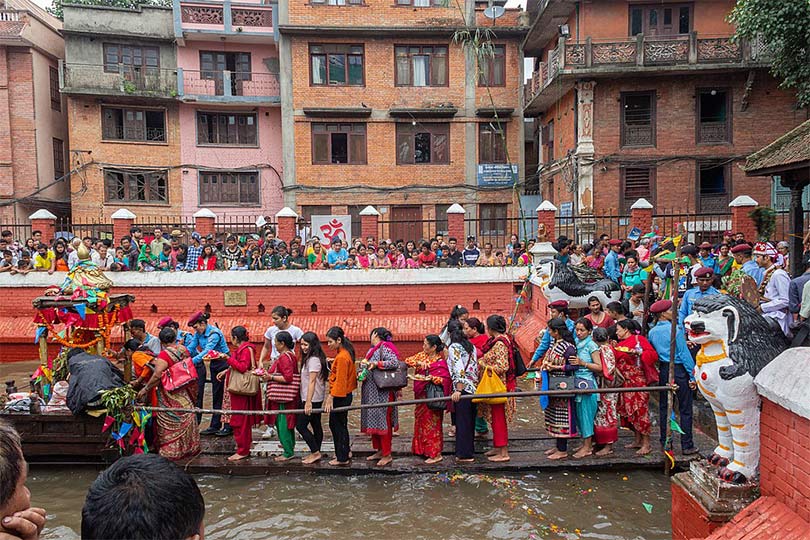
Janai Purnima is a major festival in Nepal. Hindu men renew their holy thread called ‘Janai,’ on this auspicious full moon day, thus called Janai Purnima. Further, people visit Shiva temples, and a huge Mela is held at many holy places like Gisaikunda in Rasuwa, which many devotees attend.
Apart from that, families gather together to feast on sprout lentils, commonly known as ‘Kwati’ in Nepali. Further, Janai Purnima also includes Rakshya Bandhan, a ceremony where sisters tie a thread on their brother’s hand and receive gifts. But in-depth, the tradition has a deeper meaning; it is a celebration and prayer to strengthen the love and respect in between and among sisters and brothers.
5. Teej
– The women’s festival
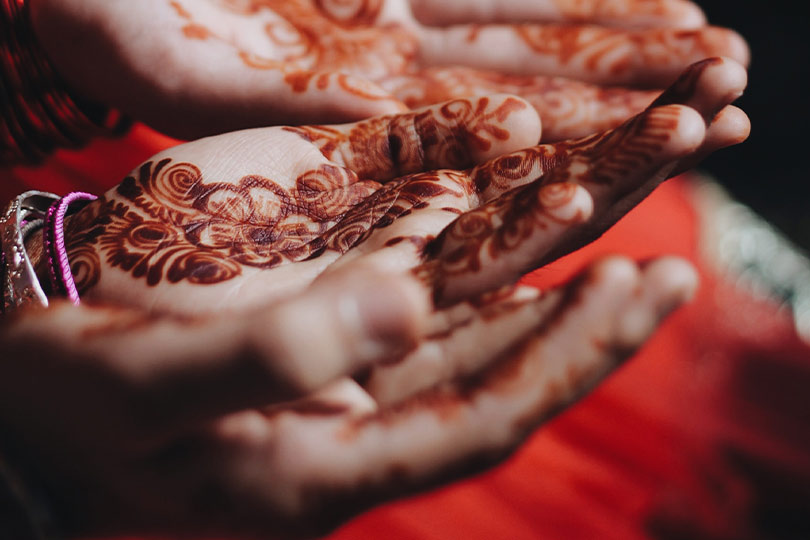
Teej is one of the major festivals in Nepal, celebrated by women all over the country. On the occasion of Teej, women wear red sarees, tika, bangles, and sing and dance for days. Traditionally, it has huge significance for married women, who visit their maternal homes and feast on traditional meals called Dar.
Following Dar, women fast for a whole day without food and drinks while singing and dancing in groups. While fasting, married women pray to Lord Shiva for their husband’s longevity and prosperity, whereas unmarried women pray to attain a good husband and marital bliss. Many women go to Pashupatinath on Teej to offer their prayers; it is a sight to behold with so many women dancing merrily. The fascinating thing is to see women of all age groups come together, young and old, dance for hours in the heat, rain without a drop of water or food for an entire day.
6. Shree Krishna Janmashtami
– Lord Krishna’s Birthday

Shree Krishna Janmashtami marks the celebration of the birth of Lord Sri Krishna. As per Hindu mythology, Lord Krishna is regarded as the 8th avatar or ‘incarnation’ of Lord Vishnu, who took birth to end the monstrosity of his evil uncle ‘Kansh.’ It falls either in August or September. Lord Krishna is a mischievous god who used to be involved in many mischievousness as a child, including breaking pots and stealing butter from villagers. So, on the occasion of Janmashtami, ceremonies are held where a pot with butter is hanged at a height, and various teams take turns to break the pot for the delicious treat. This festival is celebrated throughout the country.
7. Fagun Purnima
– A Festival of Colors
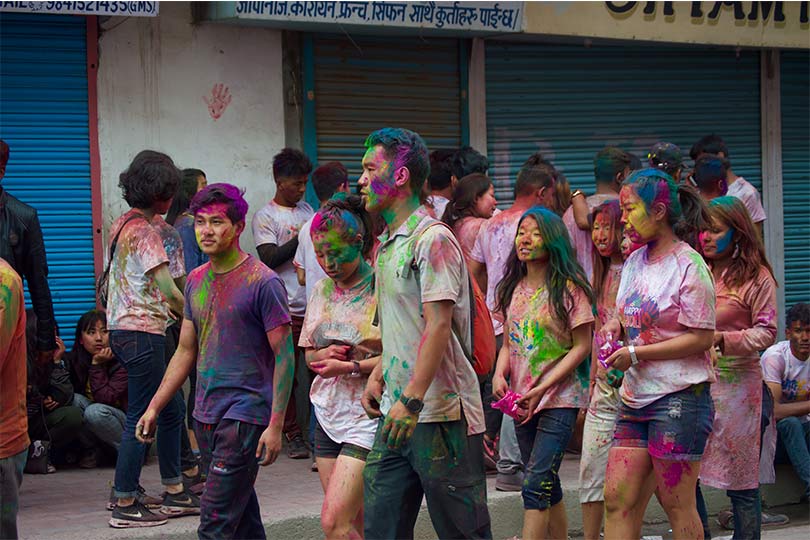
Fagun Purnima, also termed Holi, is derived from the name of mythical demoness Holika. Like many other festivals in Nepal, Holi also has a connection to Hindu mythology. It embarks the victory of good over bad. As per legends, a young boy named Prahalad was a devotee of Lord Bishnu, whom his father, demon king Mahisasur considered a mortal enemy. Filled with rage, the demon king ordered his sister Holika, who was blessed with fire immunity, to kill his own son. After which, Holika, who sat on fire holding Prahalad, but she was the one who perished in the flames while the boy lived.
And to celebrate that miracle, people play Holi- a celebration of fun, colors, and happiness. Holi falls in late February or early March. In recent years, Holi has gained popularity even among tourists.
8. Maghe Sankranti or Magh
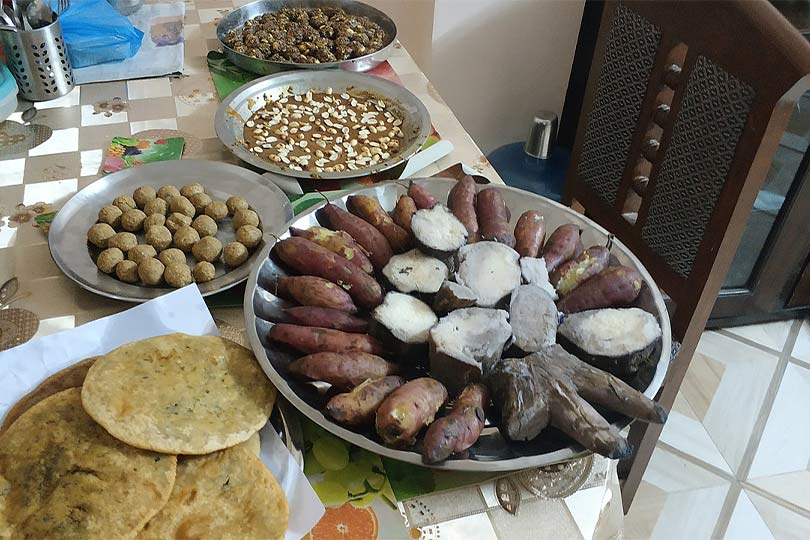
Maghe Sankranti is celebrated on the first day of the Magh months of the Nepalese calendar. It is the indication of the holy month, usually in the mid of January. The festival hopes to bring the end of the cold season and expects warmer weather and better days of health and fortune. On this day, families get together to eat delicious meals together. People eat sesame seed treats, ghee, molasses, sweet potatoes, and yams as per traditions.
Further, the same day is observed as Maghi- The New Year by the Tharu community in Terai. They celebrate it with family get-togethers, eating delicious foods, attending Melas, and dressing up in traditional wear.
9. Indrajatra
– God Indra’s Festival

Indra Jatra is one of the most exciting and revered festivals of the Newar community of the Kathmandu Valley. It is an eight-day-long Jatra festival that falls in September. This festival also marks the beginning of a month-long festival season of autumn. It is celebrated to commemorate the time when Indra came down to earth; as per Hindu mythology, Indra is the King of Heaven.
The Jatra begins with the erection of a wooden pole made of pine at Basantapur Square in front of the old Hanuman Dhoka Palace. Further, the chariot of Living Goddess Kumari is taken out for procession on the street of Kathmandu. Thousands of spectators gather to see the joyful procession led by masked dancers known as Lakhey.
10. Mahashivaratri
– The Night of Lord Shiva

Mahashivaratri, or the night of Shiva, is one of the major festivals of Nepal. Lord Shiva is a supreme god as per Hindu mythology. As per beliefs on the day of Shivratri, the stars are at an optimum position that raises spiritual energy.
On this day, thousands of Hindu devotees visit the holiest shrine of Hindus, the Pashupatinath temple, which is also considered the protector of Kathmandu valley and Nepal. For this festival, the Pashupatinath temple is covered with flowers. Lots of Sadhus come all the way from India to pray at Pashupati and perform Lord Shiva’s spiritual Tandav dance on this day. Since it’s a night festival, devotees celebrate the whole night, chanting and praying for light over darkness. At home, people gather together, light bonfires, and prepare holy meals on Shivratri.
Apart from these festivals, Nepal celebrates many other regional, communal and seasonal festivals. Since there are so many of them, any time of the year promises a rewarding festive experience. Plan your trip with Himalayan Glacier to experience the exciting festivals of Nepal. We can help you find the perfect festival and a memorable cultural trip in Nepal as per your convenience.






